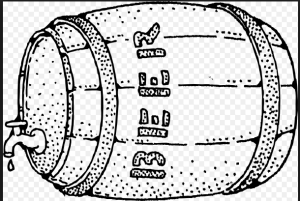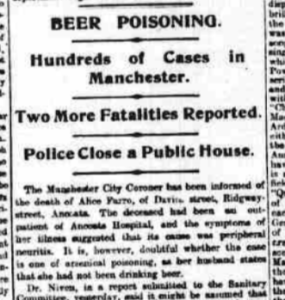In 1900 a poisoning epidemic rocked Lancashire, being felt especially keenly in Manchester and Salford. At first the cause of the poisoning was not fully realised, victims were assumed to be suffering from alcohol related complaints, such as peripheral neuritis – a condition which resulted from chronic alcohol poisoning and was characterised by muscle paralysis and loss of function in sensory nerves. Alcohol was indeed the cause but not in the way initially envisaged.
Beer had been contaminated with arsenical acid, present in glucose and invert sugar (traced to a company of sugar refiners near Liverpool) which had been manufactured from sulphuric acid containing arsenic (from a firm in Leeds).
The Ancoats Hospital was one of the institutions which saw patients admitted with symptoms and which put a strain on resources and accommodation. The wards were swamped with victims. In December 1900 there were around twenty in-patients receiving treatment for the condition and ‘are all doing well. The hospital is now quite full, as there are only two or three vacant beds….out of a total of over 100.’[1] Patients showing symptoms of peripheral neuritis also continued to come in, one being kept under observation. At one point, nearly half of the cases in out-patients showed signs of the condition.[2]
Manchester Courier and Lancashire General Advertiser, 1 December 1900
Although it was a Dr Reynolds of the Crumpsall Workhouse who first realised that it was arsenic, not alcohol which was the root cause of the epidemic, Ancoats Hospital also played a role in combating the problem. Dr RT Williamson, physician to the Hospital, produced a report to the British Medical Journal with his findings. His report centred on a 30 year old female patient, who was suffering from peripheral neuritis. Williamson could find no cause for the condition, other than through drink. He found that the only difference from ordinary cases of the condition was conjuctivitis, which he traced back to the woman’s favourite tipple, stout. Arsenic was present in the drink and also in a sample from the brewery which produced it.
Manchester Courier and Lancashire General Advertiser, 1 December 1900
The epidemic was not confined to Lancashire. Over 6000 suffered from poisoning throughout England and at least 70 died. The real death toll is thought to have been higher, as deaths were often attributed to other forms of alcohol abuse, such as cirrhosis of the liver. A Royal Commission was set up in February 1901 to look into the causes of the outbreak and to recommend safeguards for the future.[3]
[1] Manchester Courier and Lancashire General Advertiser, 1 December 1900
[2] Supplement to the Manchester Courier, 1 December 1900
[3] For further information on the outbreak see Peter Dyer, The 1900 Arsenic Poisoning Epidemic in Brewery History, no.130
Do you think this heritage is worth preserving? If so, contribute to the campaign to save Ancoats Dispensary:www.spacehive.com/thebeatingheartofancoats.
Have you got a photograph, news clipping, document, item of memorabilia, or memory about Ancoats Dispensary? If so, we would love to feature it on the blog. Please send images and descriptions to ancoatsdispensary100@gmail.com. Contributors of material will be acknowledged.



